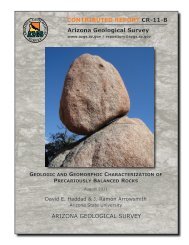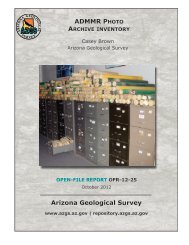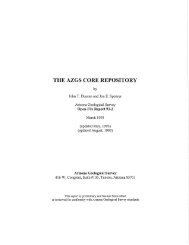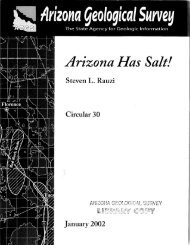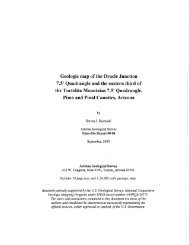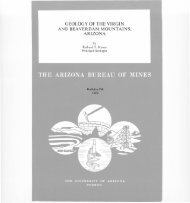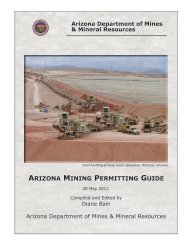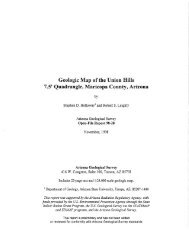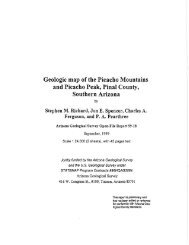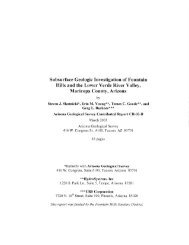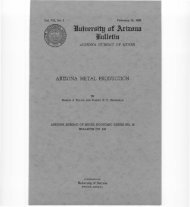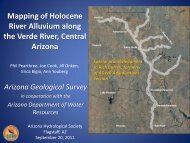Structural-Geologic Map Relationships in the Salcito Ranch Area,
Structural-Geologic Map Relationships in the Salcito Ranch Area,
Structural-Geologic Map Relationships in the Salcito Ranch Area,
Create successful ePaper yourself
Turn your PDF publications into a flip-book with our unique Google optimized e-Paper software.
<strong>Structural</strong> relationships with<strong>in</strong> <strong>the</strong> zone of cataclasis <strong>in</strong>clude <strong>the</strong> presence of<br />
discrete fault surfaces whose l<strong>in</strong>ked geometries resemble extensional duplexes<br />
bound<strong>in</strong>g horses. In this context, <strong>the</strong> subdetachment fault may well represent a "flat"<br />
that fur<strong>the</strong>r down-dip is connected with <strong>the</strong> ma<strong>in</strong> Catal<strong>in</strong>a detachment fault by a ramp.<br />
Mylonites<br />
Beneath <strong>the</strong> zone of cataclasis are beautiful mylonites, and some ultramylonites.<br />
Gently dipp<strong>in</strong>g, <strong>the</strong> mylonitic fabric imparts a ledgy characteristic to <strong>the</strong> landscape<br />
(Figure 6). Protolith is of two varieties: a coarse porphyritic quartz monzonite that may<br />
represent a part of <strong>the</strong> Precambrian Oracle/Ru<strong>in</strong> suite; and a much more volum<strong>in</strong>ous,<br />
f<strong>in</strong>er gra<strong>in</strong>ed, muscovite granite, that may represent a part of <strong>the</strong> Laramide Wilderness<br />
Granite suite (Keith and o<strong>the</strong>rs, 1980). Streaky m<strong>in</strong>eral l<strong>in</strong>eation pervades all of <strong>the</strong><br />
mylonites and ultramylonites, and it plunges very gently S50ºW. The ubiquitous sense<br />
of shear <strong>in</strong>dicator <strong>in</strong> <strong>the</strong> muscovite granite mylonite is fish-flash (Davis and Reynolds,<br />
1996, p. 523), and everywhere (with one special exception yet to be discussed) reveals<br />
a top-to-<strong>the</strong>-southwest sense of shear. In mylonite derived from Precambrian<br />
Oracle/Ru<strong>in</strong> suite, <strong>the</strong> top-to-<strong>the</strong>-southwest shear sense is aga<strong>in</strong> apparent, disclosed<br />
through S-C fabrics.<br />
The transformation of granite protolith to mylonite and ultramylonite, and to<br />
cataclasite and ultracataclasite, is beautifully recorded <strong>in</strong> microstructures <strong>in</strong> th<strong>in</strong> section.<br />
We have described this transition <strong>in</strong> Davis and o<strong>the</strong>rs (1998). To <strong>the</strong> north of <strong>the</strong> map<br />
area, we would expect that <strong>the</strong> mylonite gives way downward to nonmylonitic granitic<br />
protolith. In fact, even with<strong>in</strong> <strong>the</strong> map area we see small pockets of nonmylonitic<br />
protolith where <strong>the</strong> orig<strong>in</strong>al granites escaped complete mylonitization. We imag<strong>in</strong>e <strong>in</strong><br />
14



